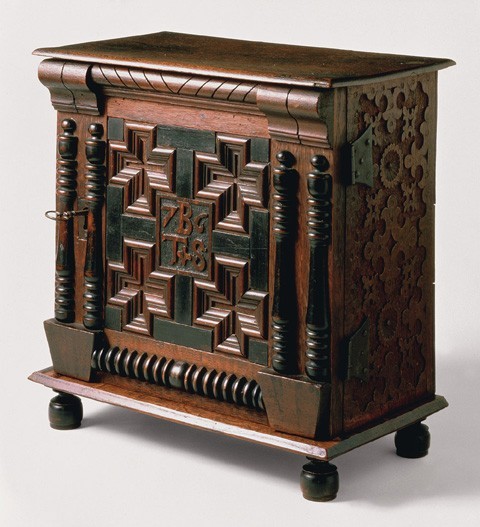
Cabinet attributed to the Symonds shops, Salem, Massachusetts, 1676. Red oak, red cedar, black walnut and soft maple (by microanalysis). H. 17 1/4", W. 17", D. 9 7/8". (Courtesy, Winterthur Museum; photo, Gavin Ashworth.)
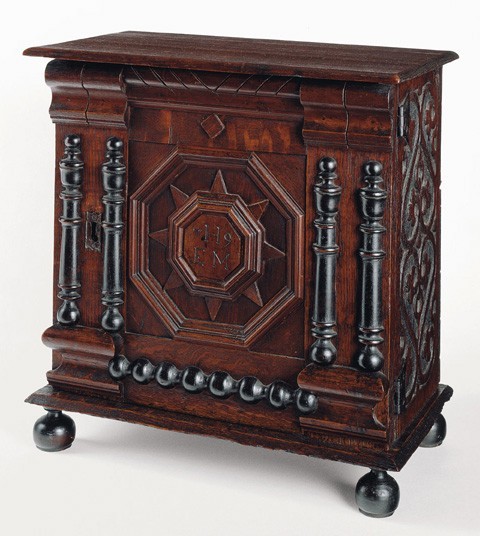
Cabinet attributed to the Symonds shops, Salem, Massachusetts, 1679. Red oak, black walnut, eastern red cedar, and soft maple with white pine (by microanalysis). H. 17 3/4", W. 17 1/4", D. 9 3/4". (Courtesy, The Metropolitan Museum of Art, gift of Mrs. Russell Sage 1909 (10.125.168); photo, Gavin Ashworth.)
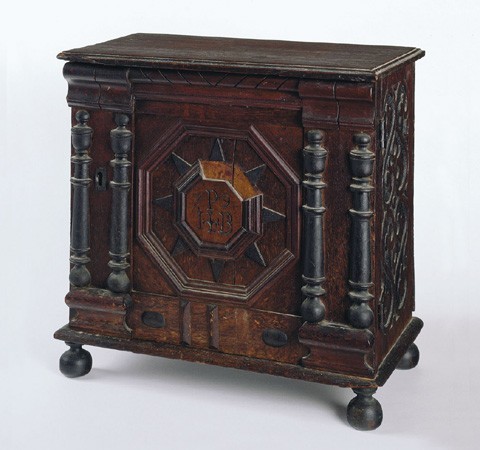
Cabinet attributed to the Symonds shops, Salem, Massachusetts, 1679. Red oak, black walnut, soft maple (by microanalysis), and cedar with pine. H. 16 3/8", W. 17", D. 9 1/2". (Courtesy, Peabody Essex Museum; photo, Gavin Ashworth.)
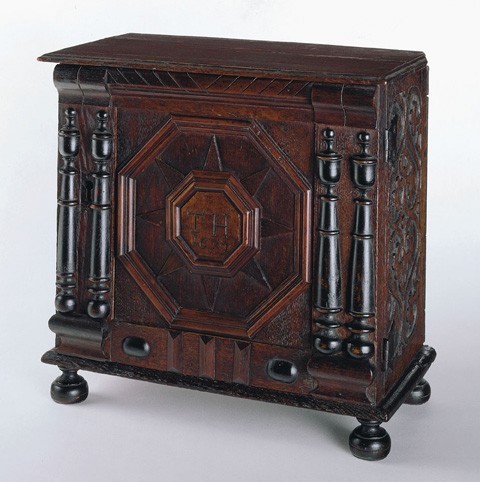
Cabinet attributed to the Symonds shops, Salem, Massachusetts, 1679. Red oak, white oak, black walnut, and soft maple with white pine (by microanalysis). H. 16 3/4", W. 17 5/16", D. 5 5/8". (Courtesy, Winterthur Museum; photo, Gavin Ashworth.)

Chest attributed to the Symonds shops, Salem, Massachusetts, 1680–1705. Red oak and unidentified woods. H. 30", W. 47 1/2", D. 21 3/4". (Courtesy, Sack Heritage Group, Inc.) www.sackheritagegroup.com

Genealogical chart showing possible lines of descent for the chests illustrated in figs. 5 and 9.
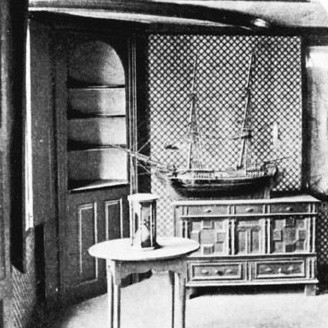
Photographs of the Trask homestead showing the chest illustrated in fig. 5. Built by William Trask in 1680, the house was owned by lineal descendants of his son John in the nineteenth century and was presumably part of the real estate inherited by John upon his father’s death in 1691. Reprinted from William Blake Trask, “CaptainWilliam Traske and Some of His Descendants,” New-England Historical and Genealogical Register 55 (July 1901), opposite p. 321.
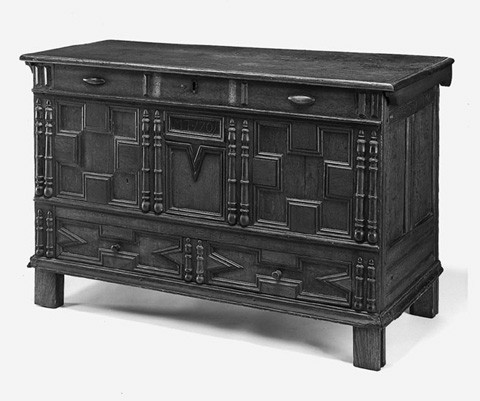
Chest attributed to the Symonds shops, Salem, Massachusetts, 1701. Oak, maple, mahogany, and red cedar (by microanalysis). H. 31 1/4", W. 47 3/4", D. 20 5/8". (Courtesy, Concord Museum, gift of Russell Kettell; photo David Bohl.) www.concordmuseum.org
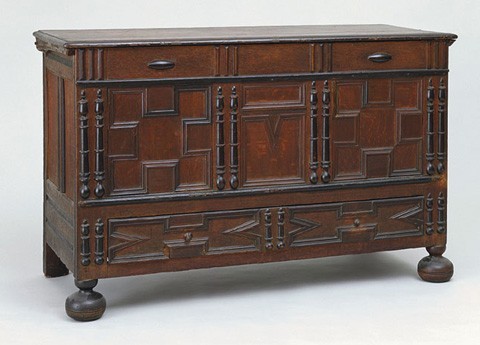
Chest attributed to the Symonds shops, Salem, Massachusetts, 1680–1705. Oak and maple with pine. H. 31", W. 45 1/2", D. 20". (Courtesy, Peabody Essex Museum.)
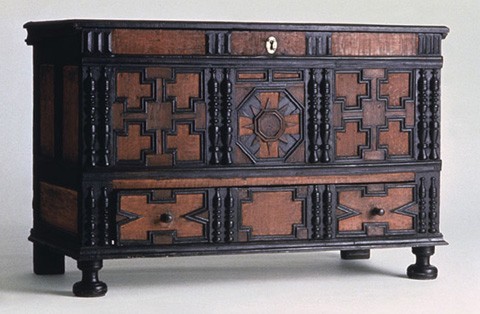
Chest attributed to the Symonds shops, Salem, Massachusetts, 1680–1700. Oak and maple with pine (by microanalysis). H. 30 1/8", W. 46 3/8", D. 221/4". (Courtesy, Winterthur Museum.)
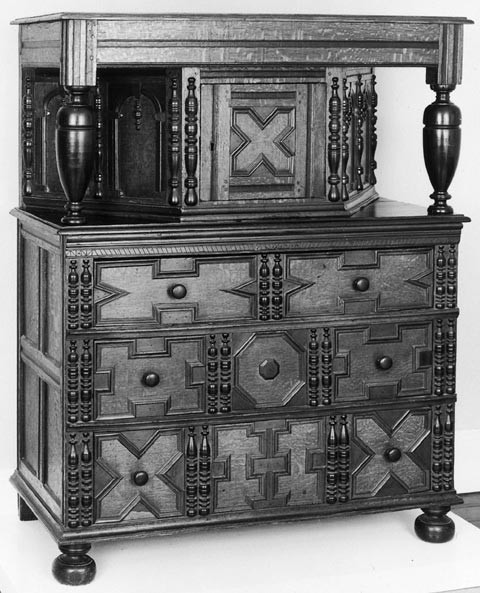
Cupboard attributed to the Symonds shops, Salem, Massachusetts, 1680–1700. Oak, maple, and walnut with pine. H. 58 3/4", W. 45", D. 21". (Courtesy, Peabody Essex Museum.)

“The Putnam (Enclosed) Court Cupboard,” Putnam Leaflets, vols. 1–2, 1896–1897, Peabody Essex Museum. This is a late-nineteenth-century photograph of the cupboard shown in fig. 11. (Courtesy, Peabody Essex Museum.)
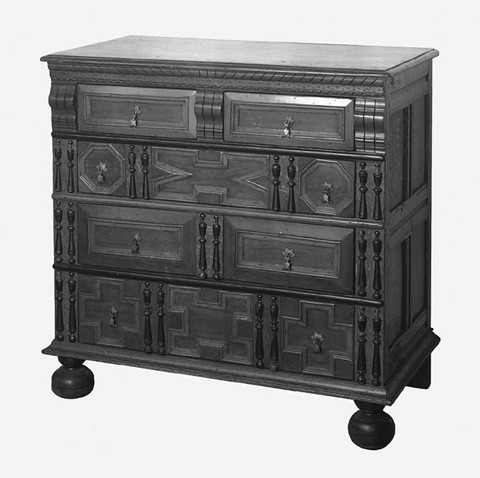
Chest of drawers attributed to the Symonds shops, Salem, Massachusetts, 1675–1700. Oak with pine. H. 38 3/4", W. 40 1/4", D. 21 3/8". (Courtesy, Museum of Fine Arts, Boston; bequest of Charles Hitchcock Tyler.)
Displaying distinctive geometric moldings, architectural appliqués, and mannerist carving, a group of furniture attributed to the Symonds shops of Salem, Massachusetts, documents the transfer of seventeenth-century British styles to New England. While previous studies of this group have focused on the products of these shops and the identities of individual tradesmen associated with them, the histories of several objects reveal networks of patronage based upon family and religious ties. Like the Townsends and Goddards of eighteenth-century Newport, the principal joiners in the Symonds shops capitalized on these and other connections to dominate the furniture-making trade in Salem.[1]
Several cupboards, chests, and cabinets now attributed to the Symonds shops appeared in early studies of Essex County furniture. In 1938, furniture historian Irving P. Lyon included several examples from the group in a series of articles on Ipswich, Massachusetts, joiner Thomas Dennis. Several decades later, Helen Park attributed two of the pieces illustrated by Lyon to Salem, citing their histories of descent in local families and that town’s pre-eminent position as the economic and furniture-producing center of Essex County. The first scholar to recognize that these objects were part of a “Salem school” was Benno Forman. He concluded that joiner John Symonds (ca. 1595–1671) was the most likely progenitor of this tradition, based on the unfinished furniture, tools, and turned components listed in his inventory. Forman also noted that the careers of John Symonds and his sons James (1633–1714) and Samuel (1638–1722) encompassed the dates ascribed to the furniture. In addition to identifying chamber tables, chairs, and other forms from the Symonds shops, Robert F. Trent strengthened Forman’s attribution by linking the furniture to architectural woodwork from John Symonds’s hometown, Great Yarmouth, in Norfolk, England. Embellished with geometric moldings, corbels, and interlacing S-scrolls, the interior paneling of the Star Hotel in Great Yarmouth has many of the same details found on furniture attributed to the Symonds shops. Trent also identified the group’s mannerist design sources and chronicled the evolution of various forms through the last decades of the seventeenth century.[2]
Eight pieces of furniture—four cabinets, three chests, and a cupboard—attributed to the Symonds shops have histories or physical evidence connecting them to their original owners. Three of the cabinets bear dates and the initials of a married couple that correspond to only one husband and wife living in Essex County at the time. Forman traced the initials on two of these examples to Thomas Buffington (1639–1728) and Sarah Southwick (1644–1733) of Salem (fig. 1) and Ephraim Herrick (1638–1693) and Mary Cross (1640–1693) of Beverly, Massachusetts (fig. 2). Neither object has a provenance, thus the identification of their original owners rests solely upon their initials. A recently discovered cabinet (fig. 3) has the initials of Joseph Pope (1650–1712) and Bathsheba Folger (1652–1726), whose identities were uncovered by their late-twentieth-century descendants, the last family members to own the piece. The fourth cabinet (fig. 4) is initialed “TH,” and, like the Herrick and Pope cabinets, it is dated 1679. This piece evidently belonged to Thomas Hart (d. 1731) of Lynnfield, Massachusetts, and passed to his brother Samuel’s family upon Thomas’ death.[3]
The chest illustrated in figure 5 probably belonged to John Trask (1678–1737) and Hannah Osborne (1679–1721) of Salem. It descended through three generations of their family to William Blake Trask (1812–1906) (fig. 6), who donated the piece to the New England Historical and Genealogical Society in 1902. An article by William published a year earlier shows the chest (fig. 7) in the house of his great-great-great grandfather, William (1640–1691). Given the similarities between this example and a related chest dated 1701 (fig. 8), it is more likely that John Trask commissioned his chest (fig. 5) around the time of his marriage than that he inherited it from his father.[4]
Another one-drawer chest (fig. 9) attributed to the Symonds shops belonged to Lyman and Elizabeth Osborne during the late nineteenth and early twentieth centuries (fig. 6). Furniture historians have speculated that it descended from Lyman’s ancestor Samuel Osborne (1675–1750), but the original owner was probably his brother John (1671–1744) or sister Hannah, who married John Trask. A nineteenth-century inscription—“Hannah Osborne 1831”—on the underside of the lid indicates that the chest came down in a branch of Elizabeth’s family.[5]
A note in the chest illustrated in figure 10 suggests that its original owners were Nathaniel (1670–1749) and Rebecca (Conant) (1671–1760) Raymond of Beverly, Massachusetts, and that the piece descended through female lines for five generations. Historian Laurel Thatcher Ulrich has shown that eighteenth-century New England women often inherited objects that “preserved their personal identity” and “ratified their connection with their family of origin.” Although furniture, needlework, and silver emblazoned with initials and dates are the most conspicuous examples of objects that “preserve lineages through time,” unmarked items with oral or written histories often performed the same function.[6]
According to its late-nineteenth-century owner, Harriet Putnam Fowler, the cupboard illustrated in figures 11 and 12 descended from Lieutenant Stephen Putnam (1694–1772) and his wife and first cousin, Miriam Putnam (b. 1698). This history is supported by the listing of the “old Fashion Cubbard” valued at eighteen shillings in Stephen’s inventory. Undoubtedly an inherited item, the cupboard could have been made for Stephen’s father, Deacon Benjamin Putnam (1664–1715), or grandfather, Lieutenant Nathaniel Putnam (1619–1700). Alternatively, Miriam’s father, John Putnam (1667–1736), or grandfather, Captain John Putnam (1627–1710), could have commissioned it.[7]
The owners of four of the objects attributed to the Symonds shops—the Popes, Buffingtons, Osbornes, and tangentially the Trasks—were closely affiliated through marriage and religious associations. The progenitors of the first three families were Quakers persecuted during the late 1650s and 1660s. As early as 1656, the General Court of the Massachusetts Bay Colony attempted to suppress the sect by imprisoning English Quakers arriving in Boston. In response to growing conversions, the court enacted numerous laws forbidding attendance of “Quaking” meetings and housing of visiting Friends. The penalties imposed on Quakers and their allies became increasingly brutal and included fines, whipping, mutilation, banishment, and hanging.[8]
With the impending arrival of English Quakers in 1657, Salem officials passed laws nearly as oppressive as those instituted in Boston. Several Friends were arrested for attending a meeting at the house of Nicholas Phelps in 1658. Among the persecuted were Joshua Buffum (1635–1705) and Lawrence (d. 1660) and Cassandra Southwick (d. 1660), whose granddaughter owned the cabinet illustrated in figure 1. All were whipped and imprisoned in Boston because there was no jail in Salem at the time. Buffum and the Southwicks continued to participate in Quaker meetings after their release and were promptly reincarcerated. Refusing to renounce their beliefs, they were banished under the threat of death. All three fled to Shelter Island, off the coast of Long Island, where Lawrence and Cassandra died in 1660. Buffum returned to Salem in 1661 and received fines throughout the decade for not attending a recognized church.[9]
Although they escaped arrest, Joseph (1607–1667) and Gertrude (Shattuck) Pope also attended the meeting at Nicholas Phelps’s house and, like Buffum, they received fines throughout the 1660s. At least five of their children married into Quaker families. The cabinet illustrated in figure 3 commemorates the 1679 marriage of Joseph Pope, Jr., and Bathsheba Folger, daughter of Nantucket Quaker Peter Folger. Joseph, Jr.’s, sisters Damaris (b. 1643) and Hannah (b. 1648) married brothers Joshua and Caleb (1650–1731) Buffum, respectively. Like his brother, Caleb was one of the more devout Quakers in Salem. He donated land for a Quaker meetinghouse in 1690 and for a burial ground in 1718.[10]
Business associations also linked the Pope and Buffum families. In 1677, Joshua Buffum charged Joseph Pope, Jr., five shillings for “a chist for Samuel Pope.” Joseph, Jr., paid his debt with “191 fut of pine bord,” a common type of exchange in seventeenth-century New England. In the same year, Buffum hired Pope and ten other men to help him move the Salem town meetinghouse.[11]
Sarah Buffington, one of the first owners of the cabinet illustrated in figure 1, was the daughter of John (1624–1672) and Sarah (Tidd) Southwick, both of whom received fines for not attending a sanctioned church during the 1660s. Although Sarah Buffington’s husband Thomas is not listed as a Quaker in Salem records, he is identified as a Friend in Buffington family accounts and all of the couple’s children were members of the sect. Their eldest son, Benjamin (b. 1699), was the second husband of Caleb Buffum’s daughter, Hannah.[12]
The Osborne family had ties to the Quaker community through William Osborne’s (1640–1729) wife, Hannah Burton (1640–1721) and their children’s marriages. During the 1660s, Hannah was fined for not attending a recognized church, as was her father, Captain John Burton (d. 1684), and brother John (b. 1640). Her father accompanied Lawrence and Cassandra Southwick’s son Josiah (1632–1693) on an exploratory journey to Rhode Island during the beginnings of Quaker persecution in 1657. The Osborne family’s relationship with the Southwicks continued through the late 1600s and early 1700s with the marriages of William and Hannah’s sons Samuel and John to sisters Eleanor (1674–1702) and Mercy (b. 1676) Southwick, daughters of Daniel Southwick (1637–1719) and granddaughters of Lawrence and Cassandra. Like his brother Josiah, Daniel Southwick adhered to his parents’ Quaker beliefs and was fined throughout the 1660s. William and Hannah Osborne’s sons also married daughters of Joshua and Caleb Buffum. After Mercy Southwick’s death, John Osborne married Hannah Buffum (b. 1677), daughter of Caleb Buffum, and Samuel Osborne’s daughter, Elizabeth (b. 1699), married Joshua Buffum (b. 1681), eldest son and namesake of the defiant Quaker carpenter.[13]
Although not a Quaker, William Trask (1640–1691) was intimately connected to the Friends community in Salem. His daughter Mary (b. 1683) married John Southwick, who may have been a grandson of Lawrence and Cassandra, and several of his nieces and nephews married Quakers. The genealogical record is unclear, but William Trask may also have been the brother of Henry (d. 1689), a Quaker who married Lawrence and Cassandra Southwick’s daughter Mary. Henry and Mary were imprisoned in Boston in 1659 and 1660 and repeatedly fined during the following decade.[14]
William Trask had extensive business dealings with Joshua Buffum. He and his brother John frequently employed Buffum to do carpentry work on their homes and mills and repaid their debts with large quantities of Indian corn. Like Joseph Pope, Jr., Trask was one of several men hired by Buffum to move the town meetinghouse in 1677.[15]
Joshua and Caleb Buffum may have been peripherally connected to the Symonds shops. Although Salem records invariably refer to them as carpenters, both men evidently made furniture. Joshua Buffum’s account book, for example, contains debit entries for inexpensive forms such as the “chist for Samuel Pope.” In 1856, Caleb Buffum’s great-great-great grandson and namesake reported seeing “several articles such as chests, etc. which . . . [the elder Caleb] made.” According to the younger Caleb (b. 1816), his great-grandfather Joshua Buffum (1719–1793) recalled visiting a shop where the elder Caleb worked. Like the Symonds, the first generation Buffums hailed from Great Yarmouth and it is likely the families knew each other before immigrating. Both John Symonds and Robert Buffum (ca. 1590–1669) had their children baptized in St. Nicholas Church in Great Yarmouth during the early 1630s. Robert owned land adjoining Symonds’s property in Salem. By 1700, these tracts had passed to the next generation. Joshua and Caleb Buffum owned agricultural land on either side of James Symonds’s fields, and all three men had houses in town. James Symonds’s house and shop were near the wharves and Joshua’s and Caleb’s homes were next to each other at the western end of town. At the very least, the Buffums may have encouraged fellow Quakers to patronize their neighbors. The Symondses were not Friends and their only familial connection to the sect was the marriage of James Symonds’s daughter Ruth to Josiah Southwick.[16]
Three pieces attributed to the Symonds shops demonstrate few or no ties to the Quaker community. Associated through marriage and geographic proximity, the original owners of the cabinet and chest illustrated in figures 2 and 10 Ephraim and Mary Herrick and Nathaniel and Rebecca Raymond—had farms and land in Beverly bordering the Royal Side section of Salem. A petition devised by Rebecca’s grandfather Roger Conant, one of the earliest settlers of Salem, reveals the common heritage of Beverly’s first families. After the town was incorporated in 1668, Conant reported that some individuals were referring to Beverly as “Beggarly” and asked the court to change the name to Budleigh, his native town in Devonshire. Nathaniel and Rebecca’s parents and Ephraim Herrick supported the petition. Like the Conants, Raymonds, and Herricks, many of Beverly’s early settlers were from England’s West Country.[17]
Thomas Hart, who lived in Lynnfield, Massachusetts, on the western side of Salem, was also related to Ephraim Herrick, albeit through a relatively circuitous route. Men from both families married daughters of Dr. Zarubbabel Endicott (1635–1684), the son of Salem’s founder John Endicott (1589–1665), a staunch opponent of the Quakers. Endicott’s daughter Sarah married Thomas Hart’s brother Samuel, and his daughter Mary married Ephraim Herrick’s brother Joseph. The Endicott family also provides a link to the Symonds family since the physician’s grandson, Zarubbabell Endicott, Jr., married Grace Symonds, the daughter of Samuel.[18]
All of the Symonds shop’s known patrons were middle- to upper-class members of the region’s farming community. With few ties to any of the aforementioned families, the Putnams were the wealthiest. Brothers Nathaniel and John Putnam, either of whom could have commissioned the cupboard shown in figure 11, were taxed ten and nine shillings, respectively, in 1683. With only 23 inhabitants paying 8 shillings or higher, the Putnams were in the top 5 percent of 700 tax-eligible residents listed in Salem. As historian Jonathan Chu has noted, the average tax rate for 1683 was 2.8 shillings.[19]
Joseph Pope, Thomas Buffington, William Osborne, and William Trask all paid taxes of 2.8 shillings or more. The Herricks, Raymonds, and Harts lived outside Salem and do not appear on the tax list; however, their probate documents indicate that they were within the same economic strata. Ephraim Herrick’s inventory, taken in 1693, totaled £483.7. By contrast, the average estate valuation in Salem was £330 between 1661 and 1681. The earliest probate data for the Raymond and Hart families is from the eighteenth century, but it suggests that the original owners of the cabinet and chest illustrated in figures 2 and 10 were relatively prosperous. Nathaniel Raymond left an estate valued at £1396 in 1749 and Thomas Hart’s sister-in-law, Sarah (Endicott) Hart, a widow whose family inherited his cabinet (fig. 2), was worth over £459 when she died in 1732.[20]
Not represented among the known patrons of the Symonds shops are members of the merchant and artisan classes living in Salem’s town center. Although many of these urban inhabitants may have purchased furniture in Boston, it is likely that some commissioned work from the Symonds shops. The Putnam cupboard (fig. 11) and the cabinets illustrated in figures 1 and 4 reflect the sophistication of Salem’s furniture makers and consumers, but chests like the ones shown in figures 5, 8 and 10 were provincial adaptations of urban forms. As furniture historians Benno Forman and Robert F. Trent have shown, Boston joiners began making chests of drawers during the 1630s. Although inventories of Salem merchants and mariners list chests of drawers as early as 1676, consumers in outlying agricultural areas were often slower to adopt new forms, as the single-drawer chests suggest. Many of the chests of drawers attributed to the Symonds shops (fig. 13) may have been owned by Salem’s urban elite.[21]
The individuals and objects discussed in this essay illustrate only a few of the myriad avenues connecting seventeenth-century artisans to their patrons and their community. Who tradesmen knew, either directly or indirectly, was often as important as what they made. The Symonds family’s links to Quakers, members of “established” churches, prominent farmers, and Salem’s urban elite enabled them to dominate the furniture-making trades in Salem during the last quarter of the seventeenth century.
For more on the Townsends and Goddards, see Jeanne Vibert Sloane, “John Cahoone and the Newport Furniture Industry,” in New England Furniture: Essays in Memory of Benno Forman, edited by Brock Jobe (Boston: Society for the Preservation of New England Antiquities, 1987); Margaretta M. Lovell, “‘Such Furniture as Will Be Most Profitable’: The Business of Cabinetmaking in Eighteenth-Century Newport,”Winterthur Portfolio 26, no. 1 (Spring 1991): 52–56; and American Furniture, edited by Luke Beckerdite (Hanover, N. H.: University Press of New England for the Chipstone Foundation, 1999), passim.
Irving P. Lyon, “The Oak Furniture of Ipswich, Massachusetts, Part V,” Antiques 33, no. 2 (June 1938): 322–25; and Irving P. Lyon, “The Oak Furniture of Ipswich, Massachusetts, Part VI,” Antiques 34, no. 2 (August 1938): 79–81. Helen Park, “The Seventeenth-Century Furniture of Essex County and Its Makers,” Antiques 78, no. 4 (October 1960): 350–55. Benno M. Forman, “The Seventeenth-Century Case Furniture of Essex County, Massachusetts, and Its Makers” (M.A. thesis, University of Delaware, 1968), pp. 42–50. Robert F. Trent, “The Symonds Joinery Shops of Salem and Their Works,” The Peabody Museum of Salem Antiques Show (Salem, Mass.: Peabody Museum, 1981), pp. 33–36. New England Begins: The Seventeenth Century, edited by Jonathan L. Fairbanks and Robert F. Trent, 3 vols. (Boston: Museum of Fine Arts, Boston, 1982), 2: 279–80, 288–89, nos. 274, 285, and 3: 526–28, nos. 484, 485. Robert F. Trent, “The Symonds Shops of Essex County, Massachusetts,” The American Craftsman and the European Tradition, 1620–1820 (Minneapolis, Minn.: Minneapolis Institute of Arts, 1989), pp. 23–41.
Althought the initials “TH” were thought to have referred to a Thomas Hart residing in Ipswich, Benno Forman discovered that the twentieth-century owner of the cabinet, Eben Parsons, was a direct descendant of Samuel Hart (d. 1731), brother of Thomas Hart of Lynnfield. Forman, “The Seventeenth-Century Case Furniture of Essex County,” pp. 111–13. Winterthur Museum object files 58.526 and 57.540, Winterthur, Delaware. Trent, “The Symonds Shops of Essex County,” pp. 34–35. Christie’s, The Joseph and Bathsheba Pope Valuables Cabinet, New York, January 21, 2000.
Because members of the Trask and Osborne families intermarried in 1701 and 1785, it is impossible to determine the chests’ lines of descent. The modern designations “Trask” chest (fig.5) and “Osborne” chest (fig. 9) derive from the names of the last family owners—William Blake Trask and Lyman and Elizabeth Osborne. Forman, “The Seventeenth-Century Case Furniture of Essex County,” pp. 108–10. William Blake Trask, “Captain William Traske and Some of His Descendants,” Genealogical Register 55, (July 1901), pp. 321–38. Sidney Perley, The History of Salem, Massachusetts, 3 vols. (Salem, Mass.: By the author, 1924–1928), 1: 322. Sotheby’s, Important Americana, New York, January 24–27, 1990, lot 1243. Israel Sack, Inc., American Antiques from Israel Sack Collection, 10 vols. (Alexandria, Va.: Highland House, 1992), 10: 2544. The Trask chest (fig. 5) was first displayed at the Museum of Fine Arts, Boston, in 1870 and was on loan there from 1912 to as late as 1968. The chest sold at auction in 1990 and is now in the collection of Israel Sack, Inc.
Perley, History of Salem, 1: 323; Forman, “The Osborne Family Chest Re-Discovered,” Historical New Hampshire 26, no. 1 (Spring 1971): 27–30. Donated to the New Hampshire Historical Society as part of the Prentis collection in 1957, the Osborne chest was recently acquired by the Peabody Essex Museum in Salem.
Object file 58.525, Winterthur Museum. In the early twentieth century, the chest belonged to Emily G. Patch, Nathaniel and Rebecca (Conant) Raymond’s great-great-great-granddaughter. The note states that the chest was owned by “Mary Raymond’s mother” and delineates its descent. Genealogical research corroborates the history. Frederick Odell Conant, A History and Genealogy of the Conant Family (Portland, Me.: Privately printed, 1887), pp. 128–31; Samuel Raymond, comp., Genealogies of the Raymond Families of New England 1630 to 1886 (New York: J. J. Little & Co., 1886), p. 123. Laurel Thatcher Ulrich, “Furniture as Social History: Gender, Property, and Memory in the Decorative Arts,” in American Furniture, edited by Luke Beckerdite (Hanover, N. H.: University Press of New England for the Chipstone Foundation, 1993), pp. 53–66.
Harriet Putnam Fowler, “History of the Old Putnam Cupboard,” The Historical Collections of the Danvers Historical Society 36 (1948), pp. 53–58. Trent, “The Symonds Shops of Essex County,” p. 36. For the Putnam family genealogy, see Perley, History of Salem, 2: 109–11. Charred surfaces on the cupboard indicate that it was in a fire. Although Putnam family tradition maintains that the piece was rescued from a fire in the home of Deacon Benjamin Putnam, Harriet Putnam Fowler has shown that the younger John Putnam’s house caught fire in 1709 and raised the possibility that the cupboard descended in Miriam’s family. In 1895, Harriet Putnam Fowler donated the cupboard to the Essex Institute. Fowler, “History of the Old Putnam Cupboard,” p. 54.
For a thorough account of Quaker persecution in Salem, see Perley, History of Salem, 2: 242–75.
For a detailed description of Joshua Buffum’s defiance, see Owen A. Perkins, comp., Buffum Family, 2 vols. (Smithtown, N. Y.: Privately printed, 1985), 2: 7–11. Jonathan M. Chu, Neighbors, Friends or Madmen: The Puritan Adjustment to Quakerism in Seventeenth-Century Massachusetts Bay (Westport, Conn.: Greenwood Press, 1985), pp. 125–75. Chu lists all of Salem’s known Quakers in the years in which they were fined, in an appendix on pages 169 and 170. Joseph Pope, Sr., received fines in 1658, 1662, and 1666 and Gertrude Pope received fines in 1658, 1660, 1661, 1662, 1663, 1664, 1665, 1666, and 1669. For more on the Pope family, see Henry Wheatland, “Notice of Some of the Descendants of Joseph Pope of Salem,” in Charles Henry Pope, A History of the Dorchester Pope Family 1634–1888 (Boston: By the author, 1888). For more on Peter Folger, see Florence Bennett Anderson, A Grandfather for Benjamin Franklin: The True Story of a Nantucket Pioneer and His Mates (Boston: Meador Publishing Company, 1940).
The Pope and Buffum families intermarried extensively in the eighteenth century. Joseph Pope, Jr., and Joshua Buffum’s grandchildren Enos Pope (1721–1813) and Lydia Buffum (1726–1781) married in the Quaker meeting house in Salem in 1749. Their marriage certificate bears the signatures of members of the Southwick, Osborne, Gaskill, Boyce, and Needham families, all of whom were descendants of seventeenth-century Salem Quakers (Marriage certificate of Enos Pope and Lydia Buffum, Salem, 1749, Enos Pope Papers, Phillips Library [hereafter cited as PL], Salem, Massachusetts).
Joshua Buffum Account Book, 1672–1705, PL, p. 14 and end leaves; Perkins, Buffum Family, 2: 15. Joseph Pope, Jr.’s, son Nathaniel (1679–1711) owned land bordering Joshua Buffum’s property and was a witness to his will in 1705.
Ralph M. Buffington, The Buffington Family in America (Houston, Tx.: Clara Dunagan Rhame, et al., 1965), pp. 293a–98. About 1770, Benjamin and Hannah Buffington moved to the Quaker community of Swansea, Massachusetts, where their descendants remained members of that faith until the mid-nineteenth century. Encyclopedia of Massachusetts: Biographical-Genealogical (New York: American Historical Society, 1917), pp. 338–39. Thomas and Sarah Buffington’s grandson James Buffington (1707–1773) attended the Quaker wedding of Enos and Lydia (Buffum) Pope (marriage certificate of Enos Pope and Lydia Buffum).
Chu, Neighbors, Friends or Madmen, appendix 1, pp. 169–70. William Osborne and Hannah Burton were married in 1672. Perley, History of Salem, 2:246.
Trask, “Captain William Traske and Some of His Descendants,” pp. 321–38. Quakers John Hill and Joseph Boyce witnessed the will of William Trask’s father. Chu, Neighbors, Friends or Madmen, appendix 1, pp. 169–70.
Joshua Buffum Account Book, pp. 50, 54–57, 118. Almost identical to the Trask and Osborne examples, the Dodge family chest bearing the initials and date “MT/1701” (fig. 8) could be another example of Symonds shop furniture belonging to this sphere of patronage. If the date corresponds to a marriage, it is possible the chest was made for Mary Kitchin who married John Turner in that year. She is the only individual recorded in Salem whose initials and date of marriage correspond to those on the chest and her uncle and aunt, John and Elizabeth Kitchin, were Quakers. The Dodge chest is now in the collections of the Concord Museum. See David F. Wood, ed., The Concord Museum: Decorative Arts from a New England Collection (Concord, Mass.: Concord Museum, 1996), pp. 6–7, cat. 3; and Chu, Neighbors, Friends or Madmen, appendix 1, pp. 169–70.
Joshua Buffum Account Book, passim. Caleb Buffum, “An Account of the Buffum Family by Caleb Buffum Written in 1856, Re-written in 1875,” Buffum Family Papers, PL, p. 7. Walter Goodwin Davis, Massachusetts and Maine Families in the Ancestry of Walter Goodwin Davis, 3 vols. (Baltimore, Md.: Genealogical Publishing, 1996), 3: 399. Walter N. Buffum, “Notes Relating to Robert Buffum and His Children,” Buffum Family Papers, PL. Sidney Perley, “Northfields, Salem, in 1700,” Essex Institute Historical Collections 49 (1913), pp. 356–67; map, William W. K. Freeman, comp., “Part of Salem in 1700 from the Researches of Sidney Perley” (Salem, Mass.: James Duncan Phillips, 1933).
For Roger Conant’s petition, see Raymond, comp., Genealogies of the Raymond Families, pp. 116–17. Cousins of Ephraim and Mary Herrick and Nathaniel and Rebecca Raymond also intermarried. Rebecca’s uncle Exercise Conant was an appraiser of Ephraim Herrick’s estate and an overseer of his will, as was William Raymond, Nathaniel’s uncle. Will and Inventory of Ephraim Herrick, October 9, 1693, Essex County Probate Records (hereafter cited as ECPR), no. 13124, Massachusetts State Archives, Boston.
Perley, History of Salem, 1: 90–91, fn. 5; 2: 256, 267–69. Richard P. Hallowell, Quaker Invasion of Massachusetts (Boston: Houghton, Mifflin, and Co., 1883), pp. 40, 191–93.
Chu, Neighbors, Friends or Madmen, pp. 128, 145–46, fn. 12.
As only about 25 percent of estates were probated and the average sum of £330 refers only to probated estates, the actual average value would have been considerably lower (ibid.). For a complete list of the 1683 tax, see Perley, History of Salem, 3: 419–22. Will and Inventory of Ephraim Herrick; Will and Inventory of Nathaniel Raymond, January 29, 1750, ECPR, no. 23277; Will and Inventory of Sarah Hart, June 25, 1733, ECPR, no. 12601.
Benno M. Forman, “The Chest of Drawers in America, 1635–1730: The Origins of the Joined Chest of Drawers,” Winterthur Portfolio 20, no. 1 (Spring 1985), pp. 1–30. Trent, “The Symonds Shops of Essex County,” pp. 27–28. For chests of drawers attributed to the Symonds shops, see Lyon, “The Oak Furniture of Ipswich, Massachusetts, Part VI,” pp. 80–81, figs. 56–59; Richard H. Randall, Jr., American Furniture in the Museum of Fine Arts, Boston (Boston: By the museum, 1965), pp. 30–33, cat. 25; and Trent, “The Symonds Shops of Essex County,” p. 38.
